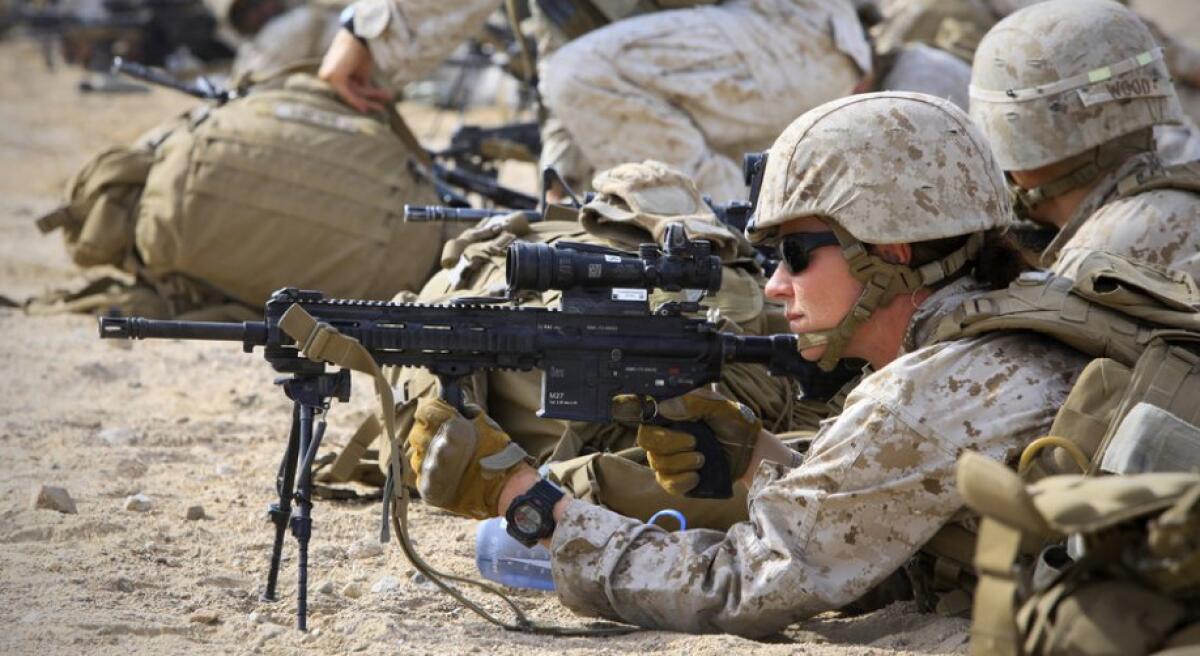Op-Ed: Women in combat? They’ve already been serving on the front lines, with heroism

Sgt. Kelly Brown, a member of the Marine Corps’ Ground Combat Element Integrated Task Force, at the Twentynine Palms combat center on Sept. 11.
- Share via
“The issue of women in combat per se was no longer a question,” said Secretary of Defense Ashton Carter on Thursday as he declared that all jobs in the United States military would at last be open to all Americans. “It was a reality, because women had seen combat throughout the wars in Iraq and Afghanistan — serving, fighting and in some cases making the ultimate sacrifice alongside their fellow comrades in arms.”
------------
FOR THE RECORD:
Combat ban: A Dec. 7 Op-Ed on women in the military stated that the Silver Star is the nation’s second-highest honor. It is the third highest.
------------
For years women served on the front lines despite the Pentagon’s official ban on women in combat. They served where needed and went where the mission demanded. Even if few Americans noticed, military leaders did, leading to Thursday’s historic announcement.
Women have served in intelligence gathering, as combat pilots, field artillery officers, special operations civil affairs officers and even in the ultra-secretive Delta Force.
In 2008, then-2nd Lieutenant Megan Turpin received the Navy and Marine Corps Commendation Medal with “V” signifying valor. She was honored for leading her supply convoy through a “56-hour odyssey” in southern Afghanistan marked by rocket-propelled grenades, explosive devices and enemy gunfire. For her part, she thought she had done nothing other than her job.
Two women have received the nation’s second-highest honor, the Silver Star, since World War II. In 2005 Sgt. Leigh Ann Hester, a soldier with the Kentucky National Guard, led the fight against insurgents who ambushed her convoy in Iraq. And in 2007, Army Specialist Monica Lin Brown, a medic, ran through gunfire to help save the lives of her fellow soldiers in Afghanistan after insurgents blew up their vehicle.
“Disregarding her own safety, Private First Class Brown shielded the casualties with her own body as large chunks of shrapnel and 5.56-mm. rounds began flying through the air from the burning vehicle,” noted her citation for the Silver Star. “The patrol leader arrived on site and found it incredible she was still alive and treating the casualties amidst the extremely dangerous conditions she was operating under.”
An estimated 300,000 women in uniform have served in the wars in Iraq and Afghanistan. Female service members have earned more than 10,000 combat action badges and Bronze Stars, respectively, and at least 12 Bronze Stars with a “V,” according to data gathered by the organization Women in International Security.
Women have served in intelligence gathering, as combat pilots, field artillery officers, special operations civil affairs officers and even in the ultra-secretive Delta Force. One hundred and sixty women have given their lives to their country. This year three women graduated from the Army Ranger School, the Army’s premier leadership course.
First Lt. Ashley White and Capt. Jenny Moreno were members of a ground-breaking all-women team recruited for special operations combat missions. Both died on night raids in southern Afghanistan alongside the elite Army Rangers. Lt. White in 2011, Capt. Moreno two years later. In October 2013, they became the first two women to be honored at the National Infantry Museum’s Memorial Walk — even though, at that time, they weren’t technically able to join the infantry.
Most in the United States have enjoyed a great distance from America’s 14 years of war in Afghanistan, Iraq and now Iraq once more. Less than half a percent of the population has fought 100% of the battles, with precious few paying close attention to the wars being fought in their names.
While we weren’t looking, the military kept fighting, but its fighting force changed. Thursday’s announcement from Secretary Carter that all jobs will be open to all warriors is less a groundbreaking policy shift than simple recognition of on-the-ground, wartime reality.
Gayle Tzemach Lemmon is a senior fellow at the Council on Foreign Relations and the author most recently of “Ashley’s War: The Untold Story of a Team of Women Soldiers on the Special Ops Battlefield.”
Follow the Opinion section on Twitter @latimesopinion and Facebook
More to Read
A cure for the common opinion
Get thought-provoking perspectives with our weekly newsletter.
You may occasionally receive promotional content from the Los Angeles Times.










